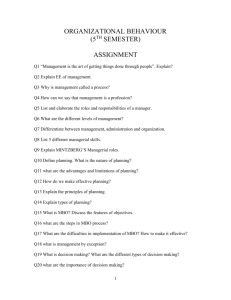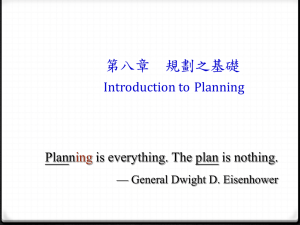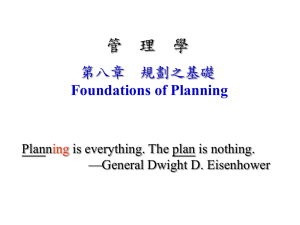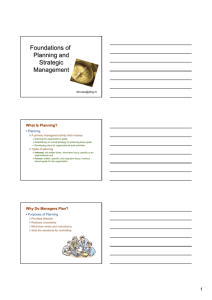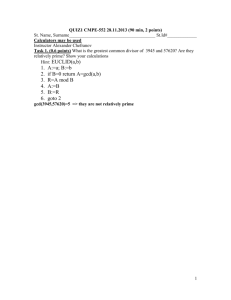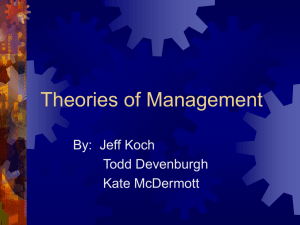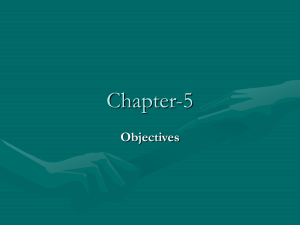orgadev3 - chaychi
advertisement
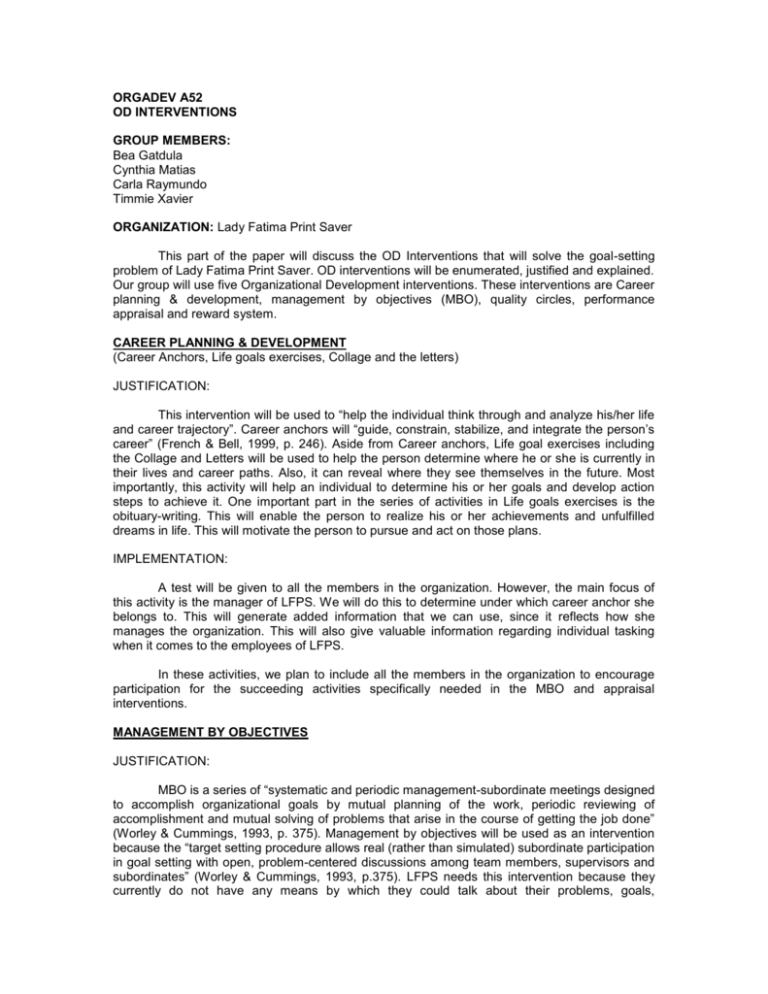
ORGADEV A52 OD INTERVENTIONS GROUP MEMBERS: Bea Gatdula Cynthia Matias Carla Raymundo Timmie Xavier ORGANIZATION: Lady Fatima Print Saver This part of the paper will discuss the OD Interventions that will solve the goal-setting problem of Lady Fatima Print Saver. OD interventions will be enumerated, justified and explained. Our group will use five Organizational Development interventions. These interventions are Career planning & development, management by objectives (MBO), quality circles, performance appraisal and reward system. CAREER PLANNING & DEVELOPMENT (Career Anchors, Life goals exercises, Collage and the letters) JUSTIFICATION: This intervention will be used to “help the individual think through and analyze his/her life and career trajectory”. Career anchors will “guide, constrain, stabilize, and integrate the person’s career” (French & Bell, 1999, p. 246). Aside from Career anchors, Life goal exercises including the Collage and Letters will be used to help the person determine where he or she is currently in their lives and career paths. Also, it can reveal where they see themselves in the future. Most importantly, this activity will help an individual to determine his or her goals and develop action steps to achieve it. One important part in the series of activities in Life goals exercises is the obituary-writing. This will enable the person to realize his or her achievements and unfulfilled dreams in life. This will motivate the person to pursue and act on those plans. IMPLEMENTATION: A test will be given to all the members in the organization. However, the main focus of this activity is the manager of LFPS. We will do this to determine under which career anchor she belongs to. This will generate added information that we can use, since it reflects how she manages the organization. This will also give valuable information regarding individual tasking when it comes to the employees of LFPS. In these activities, we plan to include all the members in the organization to encourage participation for the succeeding activities specifically needed in the MBO and appraisal interventions. MANAGEMENT BY OBJECTIVES JUSTIFICATION: MBO is a series of “systematic and periodic management-subordinate meetings designed to accomplish organizational goals by mutual planning of the work, periodic reviewing of accomplishment and mutual solving of problems that arise in the course of getting the job done” (Worley & Cummings, 1993, p. 375). Management by objectives will be used as an intervention because the “target setting procedure allows real (rather than simulated) subordinate participation in goal setting with open, problem-centered discussions among team members, supervisors and subordinates” (Worley & Cummings, 1993, p.375). LFPS needs this intervention because they currently do not have any means by which they could talk about their problems, goals, achievements and the like. As what Mrs. Matias (manager) said, “Dati, isang beses sa isang taon lang kami nakakapag meet para mapag-usapan yung takbo ng imprenta…simula nung nagkasakit ako noong 1999, hindi na ito nangyayari…ako na pati husbad ko ang gumagawa ng desisyon..yung mga bagay na gusto namin mangyari sa business.” This statement shows that employees are not given a chance to participate in goal setting due to the abolishment of their annual meetings. MBO will then enable them to meet frequently, establish goals and plan action steps to accomplish their work. Furthermore Worley & Cummings (1993) pointed out that MBO is “an attempt to align personal goals with business strategy by increasing communications and shared perceptions between the managers and subordinates either individually or as a group and by reconciling conflict where it exists” (p.374). The group believes that MBO, which involves collaborative goal setting, will result to increase employee involvement and motivation therefore improving organizational performance. In connection to this, the manager admits that meetings are important for the management and employees to talk about the current situation of LFPS. It is evident that the organization needs the MBO intervention. IMPLEMENTATION: The group intentionally designed the MBO to proceed after the life and career planning. According to Worley & Cummings (1993) the "MBO process gives attention to individuals' personal and career goals and tries to make these organizational goals more complementary" (p. 375).This means that individuals must have clear personal and career goals before the organization can create a fit between those personal goals and organizational goals. MBO will be used by the organization. Several meetings will be allotted for the formulation of goals by management together with their subordinates. With the help of a facilitator, LFPS will be able to align personal goals with work strategy, plan work, review accomplishments and solve problems in achieving goals. The steps that we will use in implementing the MBO is based on Worley & Cumming’s book entitled Organizational development and change. The six basic steps are the following: (1) work group involvement, (2) joint manager-subordinate goal setting, (3) establishment of action plans for goals, (4) establishment of criteria or yardsticks of success, (5) review and recycle and (6) maintenance of records (1993). QUALITY CIRCLES JUSTIFICATION: One of the goals of LFPS is to provide quality products and services to their customers. To prove this, one employee (Freddie Templanza, letterpress operator) during the interview said, “Ang number one na sinisigurado namin ay matapos yung trabaho ng maayos at on time… yung trabaho ba walang bulilyaso.” To ensure that this goal is carried out and maintained, we will be using the quality circles together with other interventions. Quality circle concept “is a form of group problem solving and goal-setting with a primary focus on maintaining and enhancing product quality” (French & Bell, 1999, p. 225). IMPLEMENTATION: This will be applied together with the MBO. French & Bell (1999) pointed out that, quality Circles usually consists of 7-10 voluntary employees from a unit or across units. Given the size of LFPS and the number of employees, the group will form quality circles that consist of only three employees from different functional areas; specifically coming from management and production unit. The group will meet to “analyze and make proposals about product quality and other problems” (French & Bell, 1999, p.225) Furthermore, the authors recommended that meetings be held once a week for one company hour. The next two interventions will be used to help the MBO program to be effective and successful. These are performance appraisal and reward systems (Certo, 2000). PERFORMANCE APPRAISAL JUSTIFICATION: Performance appraisal is complementary to the MBO program. Appraisal is a “feedback system that involves the direct evaluation of individual or work group performance by a supervisor, manager or peers” (Worley & Cummings, 1993, p. 378). Feedback is essential since it reminds employees about their standing in the organization and how their performance affects the organization (Hunsaker & Cook, 2001). This will help LFPS in implementing the MBO program due to open and consistent feedback from managers to workers and vice versa. It will also provide a link between goal setting and reward system (Worley & Cummings, 1993, p. 150). IMPLEMENTATION: Performance appraisal will be put into effect simultaneously with the MBO program. This intervention will require support from management. With this, management can set examples by which employees will follow and be encouraged to participate in the implementation of the performance appraisal intervention. This act will foster openness, trust, support and development in the organization (French & Bell, 1999). REWARD SYSTEM The reward system is an intervention made to improve employee satisfaction and performance (Worley & Cummings, 1993). The authors added that the intervention includes innovative approaches to pay, promotions and benefits. The reward system is based on the value expectancy mode, which holds the belief that “employees will expend effort to achieve performance goals that they believe will lead to outcomes that they value“ (Worley & Cummings, 1993, p. 384). The ability of rewards to motivate desired behavior is based on six factors. These are (1) availability, (2) timeliness, (3) performance contingency, (4) durability, (5) equity, (6) visibility (Worley & Cummings, 1993, p. 384). The author explained further that, “reward system interventions are used to solicit and maintain desired level of performance” (p. 385). This means that rewards based on the six factors can “support and reinforce organizational goals, work designs and employee involvement” (Worley & Cummings, 1993, p. 385). Some ways through which rewards may be given to employees are “pay, promotions, incentives, bonuses and benefits” (Worley & Cummings, 1993, p. 382), The reward system will “contribute to both employee fulfillment and organizational effectiveness” (p. 382). JUSTIFICATION: The reward system will be used to help the interventions especially the MBO program to be successful. (Worley & Cummings, 1993) emphasized that Management must follow through on employee performance evaluations by rewarding employees accordingly. If employees are to continue striving to reach their MBO program objectives, managers must reward those who do reach, or surpass, their objectives more than those whose performance falls short of their objectives. (p. 118) The reward system may also serve as a motivating factor for improving employee and work group satisfaction and performance (Worley & Cummings, 1993). IMPLEMENTATION: The management will give rewards to the deserving employees based on performance level. Different kinds of rewards may be used like skill based pay plans, promotions and benefits. This will be given in appropriate situations. BIBLIOGRAPHY Certo, S. (2000). Modern management: Diversity, quality, ethics and the global environment. Upper Saddle River, NJ: Prentice Hall. French, W. & Bell, C. Jr. (1999). Organizational development: Behavioral science interventions for organization improvement (6th ed.). Upper Saddle River, NJ: Prentice Hall. Hunsaker, P. & Cook, C. (2001). Management and organizational theory (3rd ed.). New York: McGraw Hill. Worley, C & Cummings, T. (1993). Organizational development and change (6th ed.). Cincinnati, OH: South-Western College Publishing.
